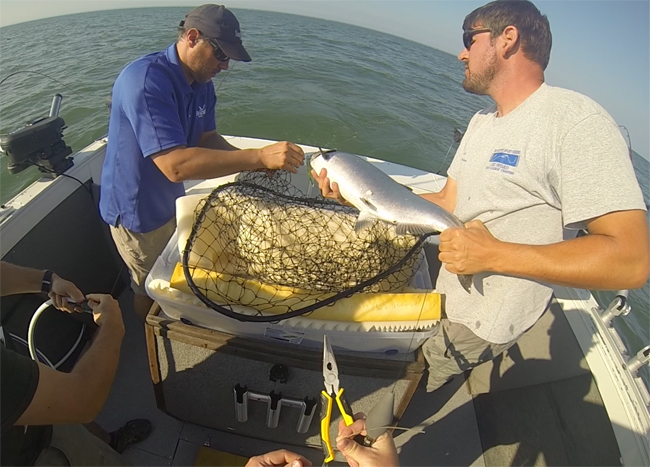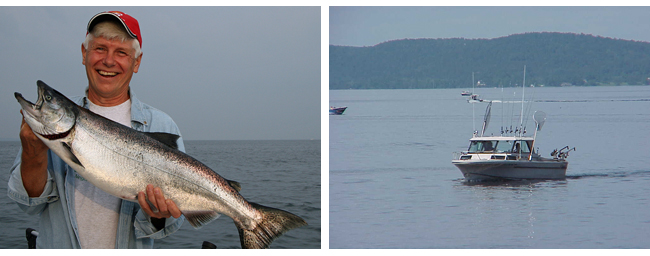New York Sea Grant's Great Lakes Fisheries Specialist discusses a recent study on King Salmon, a key fish species in Lake Ontario's ecosystem, with TV and radio outlets throughout New York's North Country.
On YouTube: Research Team Studies Salmon In Clayton (WWNY TV 7)
Clayton, NY, Nov 28, 2017 - What do king salmon do during the day? A new study with Cornell University is looking to uncover that.
We caught up with a research team conducting the study in Clayton Tuesday.
They hunt for king salmon to test their behaviors and learn their effects on the economic drive on Lake Ontario.
"We've captured and tagged these fish actually with some of these tags to gain more information about the salmon. To learn their movements during the day, we've got depth sensors in these tags as well as temperature sensors, and also accelerometers, when the fish are swimming rapidly to catch prey we can also detect that," said Jesse Lepak, New York Sea Grant's Great Lakes fisheries specialist.
New York Sea Grant is helping fund an extension of the study. The hope is that the study will give new insights about king salmon to the charter fishing industry.
WWNY TV Channel 7, a Fox affiliate station in downtown Watertown, NY, reaches a peak of 10,000 viewers in New York's Jefferson and Northern Oswego Counties during its news programming that airs in the daily 'wake-up hours" ( the 6:30-7 am stretch).

Preparing to attach a satellite tag to a Lake Ontario king salmon on a charter boat run by Rochester Sport Fishing. Credit: Cornell University
On Air: High-Tech Satellite Tags Give Unique View into the Behavior of King Salmon?? (WAER FM)
If you don't see the player above, it's because you're using a
non-Flash device (eg, iPhone or iPad). You can download the mp3 file by clicking here (mp3). It may take a few minutes to download, so please be patient.
Syracuse, NY, NOV 28, 2017 - As WAER's Scott Willis reports, Cornell University, New York Sea Grant and charter boat captains have teamed up on a high-tech mission to learn more about the behavior of King Salmon in the Lake Ontario ecosystem. They’re already getting valuable information from pop-off satellite tags attached to the fish.
New York Sea Grant's Great Lakes fisheries specialist Jesse Lepak narrated a video that shows the tagging process with the help of charter captains. It took about a month to tag 10 fish starting in early July.
"Once the fish are landed, they're put in a Styrofoam cradle to help keep them calm, and lake water is pumped across their gills so they can breathe. The fish are then tagged with a monofilament harness that connects the tag to the fish. The harness is crimped, and the excess monofilament is cut off. The tagged fish is ready to go."
Lepak says they have five of 10 tags in hand, and have some interesting data.
"Where fish are going to deeper water than we would expect, and also shallower, warmer water than we would expect. As we look more into these data, we'll be able to tell what the fish are doing. For example, the tags do have the accelerometers on them so we'll be able to see how quickly the fish are swimming in those areas."
Dr. James Watkins is a research associate at Cornell University.
"We can actually track these fish going up to the warmer surface waters where they don't prefer the warmer temperatures; and then also go down as deep as 300 feet into much cooler water than they prefer. Because we have second-by-second data, we can actually track how long they deviate from those expected temperatures."
He says so far, the data show the fish taking about 10 to 15 forays toward the surface, sometimes for only about five minutes. The deep dives last about 20. Watkins says that movement collects data about water columns, including internal waves. All of the information can serve multiple purposes.
Lepak says scientists can learn more about fish behavior, and biologists can use it to inform management decisions. Then, Watkins says, you have the anglers and charter services that are key drivers of the local economy.
"They provided their expertise and equipment to get fish for us to tag and helped us out with the tagging process. We intend to get the information we find back to the charter boat captains."
Jesse Lepak says the effort is mutually beneficial.
"We can identify locations where fish are more likely to be there and actively feeding. So, a charter boat captain may decide to go west out of the harbor instead of east one day, based on some of the conditions."
Lepak he’s been asked if they’ll tag other fish, like varieties of Trout and Sturgeon. For now, he and Watkins say they’re sticking with King Salmon.

King Salmon is a big draw for anglers in Lake Ontario. Catching one is often a lifetime dream. Credit: Wayne County Tourism
On Air: On The Line with Jesse Lepak - King Salmon's Value in the Lake Ontario Region (Galaxy Communications)
If you don't see the player above, it's because you're using a
non-Flash device (eg, iPhone or iPad). You can download the mp3 file by clicking here (mp3). It may take a few minutes to download, so please be patient.
Syracuse, NY, November 20, 2017 - Galaxy Communications Radio Group's Public Affairs Host Gary Dennis interviews New York Sea Grant Great Lakes Fisheries Specialist Jesse Lepak about a new video that highlights the value of king salmon to the Lake Ontario ecosystem and local economies, and how Cornell University researchers and Sea Grant personnel are using pop-off satellite archival tags developed to work in freshwater to collect unprecedented data about salmon movement and behavior.
During the 16-plus minute discussion, Lepak says "King (or Chinook) Salmon are a very important economic driver in Lake Ontario and the Great Lakes basin in general." Given that the fishery brings in a multitude of recreational anglers from all around the United States as well as from other countries, he adds, "We want to have a better understanding of king salmon movements and behaviors."
There's a strong need to support this multi-million dollar industry, for which Lepak cites an example: Expenditures of over $2 million are brought in annually just from the Lake Ontario-wide fall fishing derby, which takes place in August and September. "And that's not counting everyone else out there who are fishing in the region. That's just people participating in the derby."
In addition to king salmon, anglers in Lake Ontario, along the salmon River and in other tributaries within the region seek out other species while partaking in recreational sportfishing activities. These include Coho salmon and rainbow trout (steelhead).
More Info: New York Sea Grant
New York Sea Grant (NYSG), a cooperative program of Cornell University
and the State University of New York (SUNY), is one of 33 university-based
programs under the National Oceanic and Atmospheric Administration’s
National Sea Grant College Program.
Since 1971, NYSG has represented a statewide network of integrated
research, education and extension services promoting coastal community
economic vitality, environmental sustainability and citizen awareness
and understanding about the State’s marine and Great Lakes resources.
Through NYSG’s efforts, the combined talents of university scientists
and extension specialists help develop and transfer science-based
information to many coastal user groups—businesses and industries,
federal, state and local government decision-makers and agency managers,
educators, the media and the interested public.
The program maintains Great Lakes offices at Cornell University, SUNY
Buffalo, SUNY Oswego and the Wayne County Cooperative Extension office
in Newark. In the State's marine waters, NYSG has offices at Stony Brook
University in Long Island, Brooklyn College and Cornell Cooperative
Extension in NYC and Kingston in the Hudson Valley.
For updates on Sea Grant activities: www.nyseagrant.org has RSS, Facebook, Twitter, and YouTube links. NYSG produces a monthly e-newsletter, "NOAA Sea Grant's Social Media Review," via its blog, www.nyseagrant.org/blog. Our program also offers a free e-list sign up via www.nyseagrant.org/coastlines for its flagship publication, NY Coastlines/Currents, which is published quarterly.